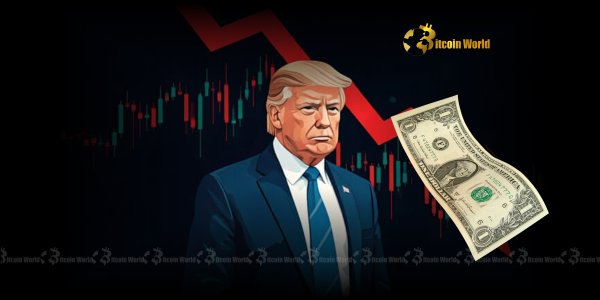US Dollar Strength: Unpacking the Shockwaves of Trump’s Tariffs on the Global Economy
0
0

In the dynamic world of global finance, events far from the cryptocurrency sphere often send powerful ripples through the market. For those tracking digital assets, understanding these macroeconomic shifts is crucial. Recently, the landscape has been dominated by significant movements in the traditional currency markets, particularly the US Dollar, which has seen remarkable US Dollar strength. This surge is largely attributed to the looming shadow of new trade policies, specifically former President Trump’s proposed tariffs, while the British Pound faces headwinds from disappointing economic data. How do these shifts in the Forex market impact the broader financial ecosystem, and what does it mean for your investment outlook?
US Dollar Strength – A Resilient Ascent Driven by Trade Policy?
The recent rally in the US Dollar strength has been a central talking point among economists and investors alike. A primary catalyst for this upward trajectory is the renewed discussion around former President Trump’s potential reintroduction of tariffs. Tariffs, essentially taxes on imported goods, are designed to make foreign products more expensive, thereby encouraging domestic production and consumption. But how do they bolster a currency?
- Safe Haven Appeal: In times of global uncertainty sparked by trade disputes, the US Dollar often acts as a safe-haven asset. Investors flock to perceived stability, increasing demand for the dollar.
- Repatriation of Capital: Tariffs can incentivize American companies to bring production back home, leading to the repatriation of foreign earnings. This conversion of foreign currencies back into dollars boosts demand.
- Inflationary Pressure: Tariffs can lead to higher domestic prices as import costs rise. While not always positive, a controlled level of inflation can sometimes be seen by central banks as a signal for potential interest rate hikes, making the currency more attractive.
- Trade Balance Expectations: The expectation that tariffs will reduce imports and boost exports can lead to a stronger trade balance, which is generally supportive of a currency.
This dynamic illustrates a complex interplay where political rhetoric directly translates into tangible market movements, affecting not just trade flows but also currency valuations on a global scale.
Sterling Weakness – Navigating the Murky Waters of Economic Data
While the US Dollar soared, the British Pound experienced considerable Sterling weakness, largely due to disappointing economic growth data. Recent reports painted a somber picture of the UK economy, with key indicators falling short of expectations.
- GDP Contraction: Preliminary Gross Domestic Product (GDP) figures showed a contraction, signaling a struggling economy potentially on the brink of recession or already in one. This immediately dampens investor confidence.
- Manufacturing Output Decline: Data revealed a significant decline in manufacturing output, reflecting reduced industrial activity and demand.
- Service Sector Slowdown: The dominant service sector, a crucial pillar of the UK economy, also showed signs of cooling, further exacerbating growth concerns.
- Wage Growth and Inflation: While inflation has been a persistent challenge, signs of weakening wage growth alongside persistent high prices create a challenging environment for consumers, further impacting economic activity.
Such weak economic data puts immense pressure on the Bank of England (BoE) regarding its monetary policy. With growth faltering, the likelihood of aggressive interest rate hikes diminishes, making the Pound less attractive to yield-seeking investors. The lingering effects of Brexit, though not directly cited in the latest data, also continue to cast a long shadow, contributing to structural challenges for the UK economy.
Trump Tariffs – What are the Broader Implications for the Global Economy?
The discussion around Trump Tariffs extends far beyond just currency valuations; it touches the very fabric of the global economy. If implemented, these tariffs could trigger a cascade of effects, reshaping international trade relations and supply chains.
- Supply Chain Disruptions: Companies reliant on global supply chains would face increased costs and uncertainty, potentially leading to diversification efforts or reshoring production, which can be costly and time-consuming.
- Inflationary Pressures: Higher import costs are often passed on to consumers, leading to increased inflation in countries imposing tariffs. This can erode purchasing power and impact consumer spending.
- Retaliatory Measures: The most significant risk is the potential for retaliatory tariffs from other nations. This tit-for-tat approach can escalate into full-blown trade wars, stifling global trade and investment.
- Reduced Global Growth: A widespread trade war would inevitably lead to a slowdown in global economic growth, impacting all nations through reduced demand and increased trade barriers.
- Impact on Emerging Markets: Developing economies, often highly dependent on international trade and foreign investment, could be particularly vulnerable to the negative fallout from trade tensions.
The prospect of such widespread disruption creates a climate of uncertainty, prompting businesses and investors to re-evaluate their strategies and risk exposures. The ripple effect can be felt in commodity markets, equity markets, and certainly, the Forex market.
Navigating the Volatile Forex Market – Opportunities and Challenges
For investors, traders, and even those in the cryptocurrency space, understanding the dynamics of the Forex market is paramount. The current environment, characterized by shifting trade policies and divergent economic data, presents both significant challenges and potential opportunities.
- For Forex Traders: Volatility, while risky, also creates opportunities for short-term gains. Understanding key economic indicators, central bank policies, and geopolitical developments becomes even more critical. Risk management strategies, such as setting stop-losses and managing position sizes, are essential.
- For Investors (Long-Term): Long-term investors need to consider how currency fluctuations impact the value of their international assets and liabilities. A stronger dollar can make US-based investments more attractive for foreign investors but can erode returns for US investors holding foreign assets.
- Impact on Cryptocurrencies: While crypto markets often operate with their own unique drivers, they are not entirely immune to traditional market forces. A stronger US Dollar, especially driven by a flight to safety, can sometimes divert capital away from riskier assets like cryptocurrencies in the short term. Conversely, if trade tensions escalate and lead to broader economic instability, some might view cryptocurrencies as an alternative store of value, though this is a more complex dynamic.
Staying informed about macro-economic trends and their potential influence on the global economy is key to making informed decisions in any financial market. Diversification across different asset classes and geographies can also help mitigate risks associated with currency volatility.
The recent strengthening of the US Dollar, fueled by the specter of new Trump Tariffs, stands in stark contrast to the pronounced Sterling weakness, which is grappling with disappointing growth figures. These contrasting narratives underscore the complex and interconnected nature of the global economy and the sensitivity of the Forex market to political shifts and economic realities. As we move forward, the interplay between trade policy, economic performance, and central bank responses will continue to dictate currency movements. For participants in all financial markets, including the burgeoning crypto space, vigilance and a deep understanding of these macro forces will be crucial for navigating the evolving landscape and seizing opportunities amidst the challenges.
To learn more about the latest Forex market trends, explore our article on key developments shaping global currencies and trade policies.
0
0
 Manage all your crypto, NFT and DeFi from one place
Manage all your crypto, NFT and DeFi from one placeSecurely connect the portfolio you’re using to start.




